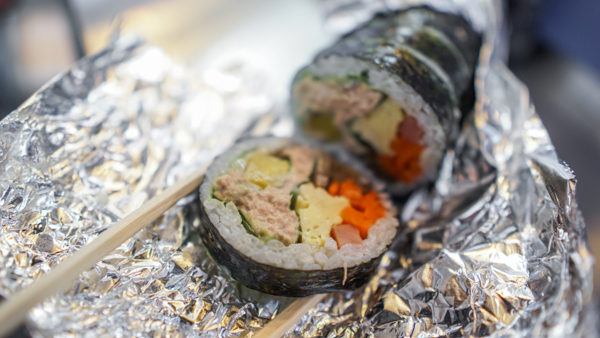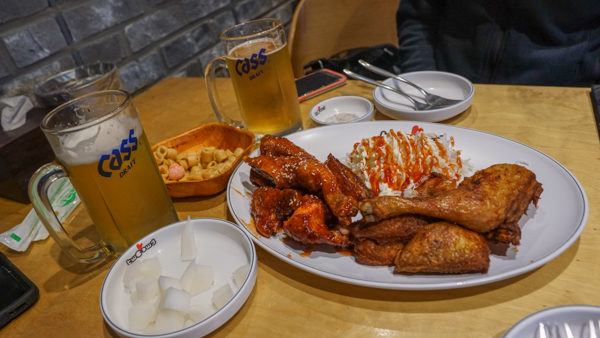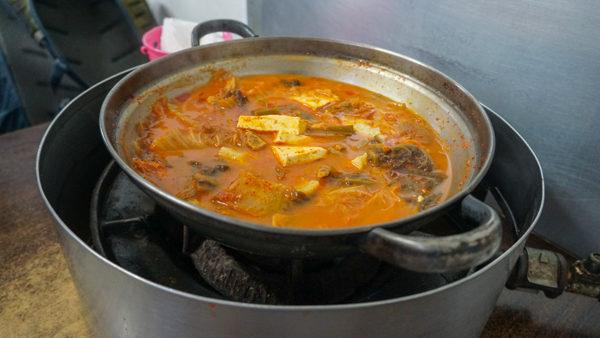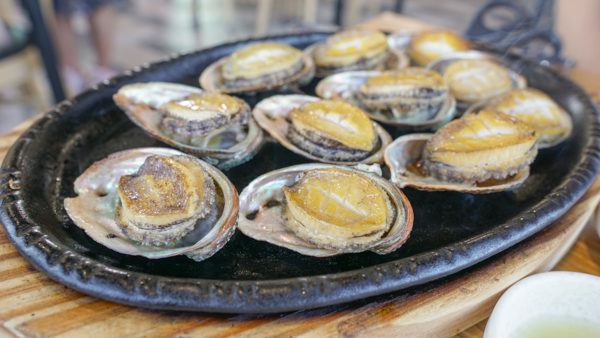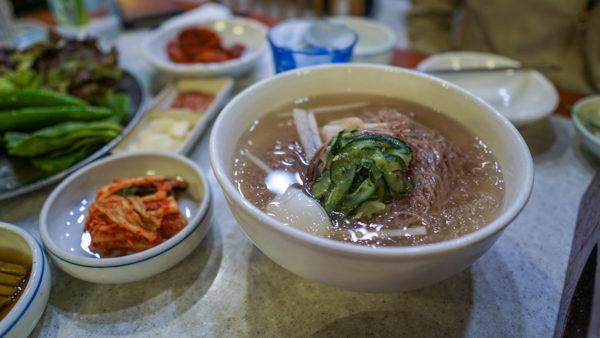Published by Jeremy. Last Updated on July 29, 2020.
Disclaimers: Our site uses demographic data, email opt-ins, display advertising, and affiliate links. Please check out our Terms and Conditions for more information. Listed prices and attraction details may have changed since our visit and initial publication.
Korean food culture is seriously no joke. You may know about kimchi, barbecue, and bibimbap, but this country’s cuisine is as varied as it is vast.
During our visit to the country, we made it our mission to try a new item in almost every meal- and accomplishing this goal was quite easy. We are not exaggerating when we say you could eat out for two weeks without having the same thing twice other than banchan (included sides). We cannot make that claim in many countries!
To help you get an idea of what you should try when visiting this delicious country, this guide was born.
This one is set up to discuss the dishes themselves, but at the end of each section we give one or two restaurant recommendations where you can find a stellar iteration!
✈️ Book Your Next Trip
- • Planning a trip? Find a flight deal.
- • In need of a room? Check out hotel and apartment prices.
- • Taking a cruise? Find a cruise itinerary for your journey.
- • Don't overlook picking up a rental car or day tours as well!
Korean Barbecue
Korean barbecue is not the kind of barbecue you’d expect from most other places around the world. Here, meat (typically pork neck or belly) is cooked on a custom griddle over hot coals or a custom gas-fired grill. It often starts as one large piece and is cut into smaller bits by your server as it cooks (although you’re more than welcome to do this yourself if you know what you’re doing).
By the time the meat is done, it is already in bite-sized pieces that can be combined with the assortment of banchan that is served along with it. This often includes salt, tiny shrimp (also salty), a spicy sauce, perilla leaves, kimchi, fermented vegetables, spicy peppers, and more. This ends up being a choose-your-own-adventure kind of meal where you may take one bite of pork neck with the spicy sauce and a perilla leaf, and then the next with just shrimp, or perhaps one with a bite of something spicy, and so on.
In fact, by our fifth barbecue experience we were almost exclusively ordering pork neck (hangjeongsal), placing a piece in a perilla leaf, and topping with a spicy sauce and a fermented vegetable. It is literally our perfect bite.
If you find yourself on Jeju Island, a barbecue experience here is a must to try the famous Jeju black pork. This comes from a smaller pig that is known for its black hair and dense fat marbling.
Great Restaurant to Try: 맛찬들왕소금구이 서면점 in Busan and Donsadon Byeolgwan in Jeju
Kimchi-jeon
“Jeon” in Korean is a generic term to describe most any food that is covered in flour and fried. One of the most common jeon you’ll find in the country is Kimchi-jeon (also called Kimchi-buchimgae) and this is essentially a fried kimchi pancake with vegetables.
We are big fans of this one over other similar style pancakes as the kimchi adds a tangy and spicy bite to it, and when you couple that with the greasy oil that soaks up in the pancake itself you get a rather delicious bite every single time. Great for a side with a meal!
Bibimbap
Bibimbap is one of the most famous dishes to come out of South Korea and is primarily a rice and vegetable bowl that comes served with a slightly spicy gochujang sauce (a staple in many Korean dishes). In Jeonju, where bibimbap was invented, this often goes one step further to have the rice cooked in beef broth and topped with raw meat, a raw egg yolk, and various kinds of nuts as well.
Other variants of this dish come out in a sizzling hot pot that slight chars the rice and cooks the vegetables to produce a warm vegetable bowl that has a lot going on in every bite.
Great Restaurant to Try: HanKookKwan in Jeonju
Japchae
Korea’s most well-known noodle dish is most likely Japchae- a sweet potato based glass noodle that is served with a mix of vegetables and a sweet soy sauce. What we love about this one is that the noodles are incredibly light and are a good vehicle for added flavors of the sweet potato and sauce to go with the vegetable mix. Another great dish to add on as a side when you see it!
Gimbap
Gimbap is a popular street food in Korea that is, essentially, sushi (large sushi at that). We found many of these from vendors at breakfast time and made for a great snack on the go with options including fish, vegetables, kimchi, and more. Great for when you need to load up on something fast and cheap!
Mandu
Most countries with a good food scene have their version of a dumpling, and in South Korea this is mandu. These dumplings are often filled with vegetables, kimchi, or meat; may have a thin wrapper or be thicker and more like a bao bun; and can come steamed, fried, or even in a soup! To say that these are versatile is an understatement, and you can try them again and again with a new flavor combination.
Great Restaurant to Try: Jaha Sonmandoo (restaurant) or Gamegol Son Wangmandu (street food) in Seoul
Korean Fried Chicken
The fried chicken scene in South Korea is no joke, with numerous restaurants serving their take on this popular food style. Many restaurants serve the chicken straight up to let the flavors of their batter come through, but often also have one or two sauces that can go along with it (go for sweet and spicy options when you can find it).
While we have to admit that we were not blown away by the chicken itself in the restaurants we tried, there is one thing we could appreciate- the size! The orders of fried chicken were also quite large, giving you ample food to enjoy with a cheap Cass beer (or three).
Kimchi Chigae
In a list of great Korean food, you’d think we would have kimchi be its own entry. But as it is often served as a side with virtually every meal as banchan, you don’t have to go out of your way to get it. But one kimchi derived dish you should check out is Kimchi Chigae- or kimchi stew.
We found this one in Seoul at a popular breakfast spot, and is essentially a heated kimchi soup with tofu and other extra vegetables thrown into the mix. It is hearty, savory, tangy, and more and is a good way to fill up before starting your day.
Great Restaurant to Try: Gwanghwamum Jip in Seoul
Abalone
Jeju Island is known far and wide for its seafood, and you can get a number of delicious dishes when eating out. But one stands out as being something rather unique to the island- abalone. This shellfish is highly sought after for its large meat and beautiful pearlescent shells.
In fact, prior to visiting Jeju we had never tried this one because it is simply far too expensive for our budget (not to mention, quite rare).
So, what is abalone like? The flavor of these is very reminiscent of a mussel, but the size and texture is more like a scallop. This one is most certainly a splurge due to its price, but is something you’ll never forget after trying!
Great Restaurant to Try: 명진전복 on Jeju
Jeju Hallabong Oranges
Jeju is also known for producing an assortment of various oranges and tangerines, and those who drive around Jeju will likely see citrus grove after citrus grove (especially towards the south). At attractions you’ll see vendors selling juice from these oranges, at tourist shops you’ll see candies and other food items made from it, and in the public markets, you’ll see the citrus fruit itself- priced by size with the largest ones being the most sought after.
Even if you go for the small ones (which are quite reasonably priced), get a kilogram to enjoy when on the island!
Great Restaurant to Try: Seogwipo Market
Udo Peanuts
The smaller, lesser-visited island of Udo (U-do) is just a short ferry ride away from Jeju, and is known for producing a very specific kind of food- peanuts! When exploring this one you can find peanuts available in a number of forms from raw to in makgeolli and even ice cream! The latter of which was our preferred way to enjoy this food item as we found one topped with whole peanuts, crumbled peanuts, and mixed into the ice cream base- perfect for a hot day after biking around Udo!
Great Restaurants to Try: Jimmy’s Ice Cream on Udo
Gejang
Gejang is a unique dish that may be off-putting to some, as it is a soy sauce marinated crab. While it is served raw, the soy sauce marinade actually cooks the crab much like you would expect from ceviche. This gives the crab meat a very interesting texture that is quite tender, and the soy sauce adds a wonderful savory flavor to the meat.
Just be warned when eating this one- getting meat out of an uncooked crab shell is difficult and messy!
Great Restaurant to Try: Jackey’s Seafood at Jagalachi Market in Busan
Kalbi
Kalbi is made from beef short rib and is often reformed into a sausage patty. In fact, this one is served with a sweet sauce and is quite reminiscent of sausage when you eat it- just significantly higher quality.
Couple that with a fried egg, rice, and kimchi and you have the makings of a delicious meal with a sweet component you don’t get in many Korean dishes!
Naengmyeon
Naengmyeon is a popular dish made with buckwheat noodles, vegetables, and is often sold cold! This one is a popular dish found prominently in North Korea but is served in South Korea as well.
In our iteration of this dish, we found ice cubes in the broth, meaning that as soon as the noodles were finished cooking it was flash cooled to be served at the intended temperature without overcooking. Simple, but delicious!
Bulgogi
While beef is fairly rare in South Korea, one of the most popular dishes to enjoy it in is bulgogi. This one is thinly sliced pieces of beef in a sweetened soy marinade that is served with vegetables and a spread of banchan. This one can be cooked on a griddle similar to Korean or be cooked in a kitchen and served in a bowl with its drippings (as pictured). In any case, you get a thin cut, greasy piece of meat with a subtle sweetness that we absolutely love.
Shame it is so expensive!
A variant you may also want to look out for is Daeji Bulgogi- a comparable dish made of pork and served with a spicier (not sweet) red sauce.
Great Restaurant to Try: 인사동 한가네 불고기주막 in Seoul
Hwangnam Bread
Hwangnam Bread is a specialty of Gyeongju, just about 90 minutes north of Busan. This bread is stuffed with red bean paste and can be found in many stores and bakeries around the city. While this one is completely savory, it makes for a hearty treat or breakfast and is the perfect kind of food to order for the road. In fact, the bakery we visited only sold them in a 20-count box (with a price to match), which means we enjoyed them for many days!
Great Restaurant to Try: Hwangnam Bakery in Gyeongju
Hotteok
Hotteok is a popular street food item in Seoul and is a fried disk often filled with honey and peanuts, but can also be found featuring other nuts as well (so if you have an allergy, like Angie does, skip this one). The fried diskes are prepared quite thin and offer a nice balance of honey and fried batter in every bite and is a delicious item to enjoy when walking around.
Great Restaurant to Try: Street food vendor across from Maker’s Hotel in Seoul.
Soju
The most popular spirit in South Korea is, without a doubt, soju. This rice-based spirit is often served in smaller bottles and diluted to an approachable 16-20%, making it easy to consume larger volumes than you should. While most of the soju you will likely find comes from one of the larger producers in the country, this one goes great with barbecue and other meat-forward dishes!
Makgeolli
Makgeolli is a lesser-known alcohol for those not from Korea, and is our favorite out of all of the alcohols we tried in the country. This is essentially a fermented rice wine (more of a beer, really) and is quite tangy and often does not tastes like it is 6-8% abv. If you are a fan of sour beer, odds are good you’ll love makgeolli as the flavor profile is quite similar.
Unlike Soju, this one is often served in 2L kettles and also makes for a fun evening after it sneaks up on you from drinking too much!
Great Restaurant to Try: Yetchon Makgeolli in Jeonju
Dongdongju
In a way, dongdongju is not much different from makgeolli. The starting process is quite similar but is often set up with a faster fermentation period and filtered in such a way that rice particles pass through into the final product (resulting in floating rice particles in the final drink). We found dongdongju as being house-made and perhaps just a bit tangier than makgeolli overall- perfect for those who can’t get enough of this alcohol style.
Great Restaurant to Try: Suk Yeong Sikdang in Gyeongju
Bonus Item – Banchan
Our final Korean food worth highlighting is not a specific item, but rather banchan at large. We call this one a bonus because you do not need to go out of your way to try it. If you go to a traditional restaurant, you’re more or less guaranteed to get an assortment of banchan brought out to your table that includes kimchi, fermented vegetables, perhaps a fried fish, an egg casserole, and more. Sometimes you may just get two or three, and in other cases, you may get close to 20 with your meal!
Have you eaten your way around South Korea? What was your favorite food? Comment below to share!
For more of our favorite food travel experiences, click the previous link!
About Jeremy

About the Author: Jeremy is a full-time travel writer based in Pittsburgh and primary author of this site. He has been to 70+ countries on five continents and seeks out new food, adventure activities, and off-the-beaten-path experiences wherever he travels.






